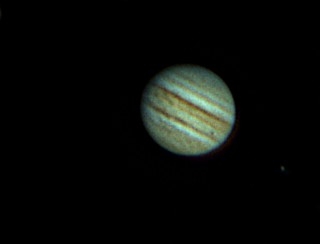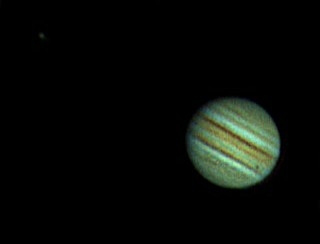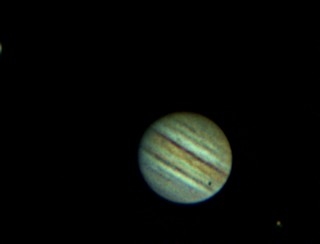-
Posts
3,757 -
Joined
-
Last visited
Content Type
Profiles
Forums
Gallery
Events
Blogs
Posts posted by Cosmic Geoff
-
-
I managed to fit a Canon 300D camera to a Startravel ST102. It needed a T2 extension tube about 2 inches long to make it work.
I regulary use the scope with a ASI224MC camera and a SVbony helical focuser (no diagonal or extensions).
-
I saw Venus last evening (17th Nov) for the first time in months. Spotted it at around 203 deg azimuth, 8 deg altitude, in between rooftops to SSW at around 16.50pm. I first saw it from the bathroom window & managed to find a spot in the garden where I could view it with my 127mm Mak. Saw crescent.
-
Do you intend to do any deep-space imaging? If you do, you need to choose the mount with that purpose in mind.
If you do not, be aware that the technique (lucky imaging with video) used for planetary imaging is highly tolerant of mount vibration, drift, etc, so the same kind of mount used for visual observation can be used. It does not even have to be an equatorial, as the individual exposures are very short. This could result in a significant economy...
I managed to obtain some satisfactory planetary images using a Celestron SLT light duty alt-azimuth GoTo mount and a Celestron 127mm Mak, similar to yours.
It is also perfectly possible to perform planetary imaging with a driven equatorial, non-GoTo mount.
-
Let's be clear about what the Starsense (camera +handset) does. It automatically performs a star alignment, saving one the bother of choosing alignment stars, finding one of them in the finder, then the main scope, and performing a 2-star align or autoalign. While the Starsense is doing its thing, you could be moving accessory gear outside.
Starsense works by plate-solving, but it is not a direct equivalent of the plate-solve you can perform yourself with your own camera and software. The results of a Starsense plate-solve cannot be directly accessed.
I have found that the Starsense is of most benefit when attached to a quick-deploy setup like my C8 SE, where the whole assemblage can be caried outside as a single unit, Starsense started and the setup ready for observing within minutes (ignoring cool-down time). Personally I have not found the Starsense to be as accurate as a good 2-star auto-align. but it is accurate enough to get objects into a low-power eyepiece and it certainly saves some annoying fiddling about and crouching. And the handset has some handy object lists.
If you have a heavy kit that needs to be assembled before use, and which has GPS, the time taken by doing a 2-star align is a small proportion of the total assembly & setup time (typically 20-30 minutes), and it hardly seems worthwhile attaching a £300+ accessory to shave a little off this time.
What kind of imaging are you intending to carry out? Your choice of scope and mount implies that you have in mind either planetary imaging, or deep-space imaging of small objects. Be advised that while the former should be fine, the latter is by all accounts NOT for beginners.
I have tried unguided images of planetary nebulae with a C8 and the images are no sharper (allowing for the difference in image scale) than those taken through a much cheaper 102mm achro refractor. You may get more satisfying results if you start your deep-space imaging with a small hgh-quality refractor, or even a camera + telephoto lens. Have you acquired and read the book "Making Every Photon Count" by Steve Richards? It is repeatedly recommended here as a guide for would-be astro imagers.
-
Some images of Jupiter including a transit by Europa's shadow. 127mm Maksutov, ASI224MC camera, captured with Sharpcap4, processed with Registax6. Because of a mistake with a newer laptop and software, I recorded the videos as thousands of .fits files and had to figure out a way of converting them to something usable (=use PIPP to output an .avi file).
The images have turned out much better than I expected - I noted the seeing as "not good". I have had worse results with my 8" SCT which seems to under-perform unless the seeing is really good.
-
 10
10
-
-
16 minutes ago, JayJay007 said:
Basically is it easier to find things with an 8 or 10" and the smaller you go a computer is needed!
Absolutely not. The bigger instruments tend to have a smaller field of view making it harder to find anything. Whether you have GoTo or not is a personal choice. Some people like to 'keep it simple' and enjoy the prolonged hunt of finding faint objects manually. Others appreciate the time-saving of having the GoTo tech find objects for you quickly. And if you want to image, having an adequate GoTo mount is even more desirable.
-
 1
1
-
-
8 hours ago, neil phillips said:
Very underrated beginner scopes these Pete. The nearly F13 Focal length really helping the lens perform well at only 70mm. Think of the price tags of those 80mm F15 Achromatic refractors. And you have these largely ignored because i guess people think they cant possibly be any good. Well i beg to differ. The results i get are consistently good. Got mine for £39
Neil's image with the 70mm is excellent for a telescope of that aperture.
Before you all rush out to buy a cheap small refractor 🙂, I should point out that some years ago I bought a 70mm supermarket refractor (the one in my signature image), and I eventually realised, after buying other instruments, that the objective was rubbish (though other people claimed good experiences with the same Lidl bargain model).
I still have a 70mm vintage brass refractor which performs superbly when rigged and mounted for astro use but I have not had it outside for two years, as it does nothing I can't do with my 127mm Mak, which is much easier to manage and also slightly lighter in weight.
-
It's closer to 5.4 KG.
I am not young, but I can still lift the whole C8 SE assembly - OTA, mount and tripod. Saves a lot of setup time. BTW it seems the OTA and SE mount are intended to be kept as a unit - handling that fat OTA on its own without a grab handle needs two hands.
-
50 minutes ago, sw89 said:
I believe a refractor type would be good for our uses, With an EQ mount over AZ - i'm a professional photographer by trade and as such may want to use this to then venture into astrophotography also.
If you want cheap, portable, suitable for visual and suitable for astrophotography, please be aware that you can only achieve one or at most two of these aims at once.
'Cheap and portable' works.
'Astrophotography' and any other of those aims, particularly 'cheap' may not work.
EQ mounts are not required except for long exposure deep space astrophotography. For anything else, the extra complication is a liability.
-
Or reduce the size/thickness of the nylon pads? I see no reason for having a tight fit.
-
2 hours ago, chrisdg1968 said:
I’ve got a fairly stock standard 90 degree mirror and a 45 degree prism.
Amber alert! The 45 degree prism is probably not fit for astro use unless explicitly designed and sold for that purpose.
I have a 127mm Celestron Mak and the star test with it is superb provided a decent eyepiece is used and not the 'starter eyepieces that come with it (the 9 or 10mm are especially poor). I used my Mak for imaging Jupiter once or twice and got an image showing the size and shape of the Great Red Spot, which proves there was nothing at all wrong with that particular instrument for planetary observation.
The Maksutovs in gereral have a fine reputation so your problem may not be with the instrument itself but with the eyepiece or diagonal(s) or the length of time allowed for cooling.
-
ZWO ASI224MC.
I assume you have planetary imaging in mind.
-
A couple of nights ago I had an odd issue with my C8 SE. In the middle of a GoTo, the tube descended rapidly downwards, losing the alignment, but after re-starting the mount I was able to carry on with the session. It's not clear whether an electrical glitch caused the problem but the vertical clutch did feel rather loose in the downward direction.
I subsequently tightened the clutch as follows: Behind the handset storage recess is a small cover which can be removed by undoing 3 Philips screws to reveal a large nut. Give the nut (size approx 1 3/16" ) a tweak of a few degrees clockwise with a suitable spanner.
-
12 hours ago, bilbs84 said:
a few hundred bucks on a decent tripod.
Sounds a lot. I made a wooden tripod for my SLT GoTo mount, attaching three 35mm square legs to a spare "bowl" SLT tripod head. I f you are not handy with tools, tripods (in the UK) are relatively inexpensive, and we can buy a flat-topped version of the heavy tripod used with the EQ-5 and AZ-4-2 mounts for a little over £100. I don't think you need a massive tripod to mount a camera tracker.
-
I have a similar power tank and I have never paid any attention to the state of charge test. Connecting a charger gives a better indication of how discharged it is. AFAIK these powertanks are very reliable.
-
Even cardboard works for a SCT. And almost all refractors have a dew shield.
-
I would suggest that if your 130 PS is of good quality, you will not see much difference for viewing planets if you change to another scope of similar aperture. Though an eyepiece upgrade might improve matters. If you go to a bigger aperture (e.g 8", 203mm) that will give an improved view of planets (if the seeing is good) but not an earth-shattering difference.
Personally, I have found that going to planetary imaging (with a planetary video camera and 'lucky' imaging) gets the ultimate out of a visual telescope - a few days ago I got, after processing, clearly defined images of a moon shadow that I could barely see (or not at all) through the eyepiece.
GoTo can be of immense help, depending on what kind of observing you want to do. You don't need it to find Jupiter, but finding Neptune will be a severe pain without it. And if you want to find and image objects on the limits of visibility, the ability to find the right area (with GoTo), plate-solve it and then at the click of a mouse reposition the scope to get the (visually invisible) object dead centre is amazing and an aid that only a diehard would want to do without.
If you want a better scope purely for visual use with GoTo, you can consider the Celestron C8 SE (a complete setup, not a scope, and one of several that mount the same OTA).
I am not clear why you were considering the EQ-6. This is an extremely heavy mount, and is mostly used by deep space imagers to rigidly mount a amall high quality refractor. It is also capable of mounting a large, heavy newtonian (etc.) For pure visual use an equatorial is a liability, as there is eatra effort involved for assembly and setup, for no practical gain compared with an alt-azimuth GoTo.
Deep space and planetary imaging have quite different requirements. If you want to cover visual, planetry imaging and deep space imaging, it helps to have several scopes and mounts so you can mix and match as required.
-
You need very dark skies to see galaxies. From a town all you will see are a few faint grey smudges, nothing like the photographs.
-
Can general visitors to the RGO see the Great Equatorial Telescope? I had a good look online but am none the wiser.
-
Check the weight of your intended 120mm OTA purchase. You may find that a substantial mount and steel-legged tripod is indicated, unless you are tolerant of wobble-mounts.
-
 1
1
-
-
You mean, repurposed without too much engineering effort? It could certainly be re-used for something, possibly by making up an adaptor.
However, a larger refractor will probably require a more substantial mount - even my vintage 70mm brass refractor required an AZ-4 steel-legged (q.v.)
And moderm mounts generally come with a tripod included, and the included value of even a tripod like that used under the AZ-5 and EQ-5 mount is qiote low. A flat-topped version of the EQ-5 tripod sells for a little over £100.
-
 1
1
-
-
Despite having visited the Greenwich Observatory some years ago, I was unaware that such a large refractor was there, or that it had been at Herstmonceux (which I have also visited). A most interesting post and links.
-
4 hours ago, tooth_dr said:
I've never used the Nexstar range, it was just suggested elsewhere, but I dont think it's particularly great???
I have three Nexstar alt-az mounts as well as a Sky-watcher EQ5 Synscan. The Nexstar system IMHO is a better designed and easier to use system, and for visual use I would recommend the Nexstar. I have not seen the equatorial version (by which we most likely mean the AVX here). As for the Synscan even though this is very popular I found it unintuitive with features present in the Nexstar either missing or hard to use, and the star align is also harder to use - without prior planning the 3-star align is almost impossible to use.
I would say that spending £1500 on a telescope outfit could be unwise unless one has a very clear idea how it it to be used. A HEQ5 could be put to various uses, if need be. A large aperture is not needed for deep sky imaging, it seems, unless one has small distant galaxies in mind, but it is desirable for planetary imaging. If one does not intend to do deep sky imaging, there is no need to suffer the aggro of an equatorial mount (or Synscan), as an alt-az will be entirely adequate for visual, or planetary imaging. Conversely, the Celestron C8 SE is a portable and easy to use outfit, very suitable for visual use, but a bit of a pain for planetary imaging and, (I expect) useless for deep sky imaging.
-
 1
1
-
-
You can easily diagnose a loose clutch. The clutch is what prevents the tube moving freely in altitude. Just try moving the OTA up and down while the outfit is indoors. There should be moderate resistance. The OTA should be positioned fully forward in the clamp.











Problems (or features?!) of NexStar SLT Alt-Az mount
in Discussions - Mounts
Posted
I do not recommend the use of AA batteries. The main purpose of the battery holder is to avoid having to bundle a PSU with the mount, which would increase the selling price. Instead use a +12v 'power tank' or a mains powered PSU.
I have used my Nexstar SLT mount for imaging, mainly with a 102mm f5 achro refractor, but the mount is barely accurate enough for this. It does tend to drift about, and this is also noticeable when using it for planetary imaging with a 127mm Maksutov, where a very small active FOV is used.
With a 102mm f5 achro + ASI224MC camera, exposures of a few seconds for deep space imaging are possible.
For better imaging performance, you could upgrade to a Synscan EQ-5 mount. I don't like the Synscan operating system, but with the addition of software and a link cable to give platesolving and resync, the performance is impressive.